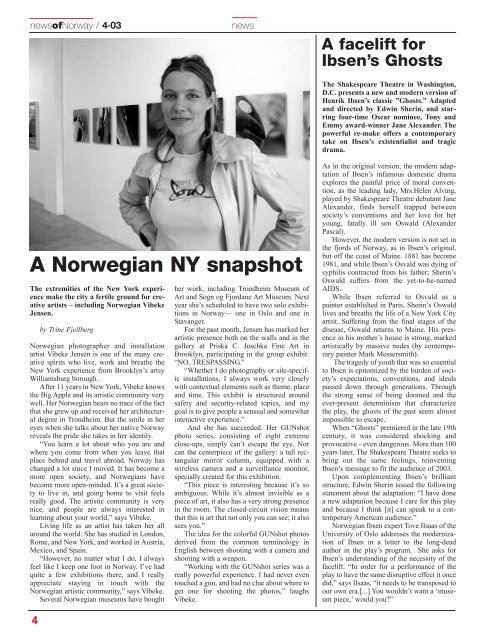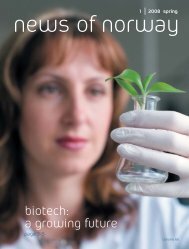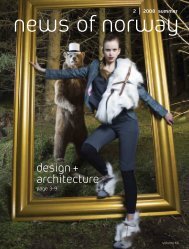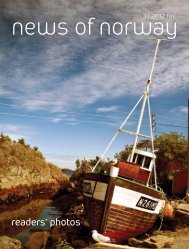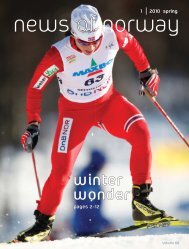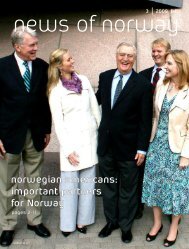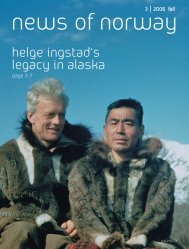newsofNorway
newsofNorway
newsofNorway
You also want an ePaper? Increase the reach of your titles
YUMPU automatically turns print PDFs into web optimized ePapers that Google loves.
<strong>newsofNorway</strong> / 4·03<br />
news<br />
A facelift for<br />
Ibsen’s Ghosts<br />
The Shakespeare Theatre in Washington,<br />
D.C. presents a new and modern version of<br />
Henrik Ibsen’s classic ”Ghosts.” Adapted<br />
and directed by Edwin Sherin, and starring<br />
four-time Oscar nominee, Tony and<br />
Emmy award-winner Jane Alexander. The<br />
powerful re-make offers a contemporary<br />
take on Ibsen’s existentialist and tragic<br />
drama.<br />
A Norwegian NY snapshot<br />
The extremities of the New York experience<br />
make the city a fertile ground for creative<br />
artists – including Norwegian Vibeke<br />
Jensen.<br />
by Trine Fjellberg<br />
Norwegian photographer and installation<br />
artist Vibeke Jensen is one of the many creative<br />
spirits who live, work and breathe the<br />
New York experience from Brooklyn’s artsy<br />
Williamsburg borough.<br />
After 11 years in New York, Vibeke knows<br />
the Big Apple and its artistic community very<br />
well. Her Norwegian bears no trace of the fact<br />
that she grew up and received her architectural<br />
degree in Trondheim. But the smile in her<br />
eyes when she talks about her native Norway<br />
reveals the pride she takes in her identity.<br />
“You learn a lot about who you are and<br />
where you come from when you leave that<br />
place behind and travel abroad. Norway has<br />
changed a lot since I moved. It has become a<br />
more open society, and Norwegians have<br />
become more open-minded. It’s a great society<br />
to live in, and going home to visit feels<br />
really good. The artistic community is very<br />
nice, and people are always interested in<br />
learning about your world,” says Vibeke.<br />
Living life as an artist has taken her all<br />
around the world. She has studied in London,<br />
Rome, and New York, and worked in Austria,<br />
Mexico, and Spain.<br />
“However, no matter what I do, I always<br />
feel like I keep one foot in Norway. I’ve had<br />
quite a few exhibitions there, and I really<br />
appreciate staying in touch with the<br />
Norwegian artistic community,” says Vibeke.<br />
Several Norwegian museums have bought<br />
her work, including Trondheim Museum of<br />
Art and Sogn og Fjordane Art Museum. Next<br />
year she’s scheduled to have two solo exhibitions<br />
in Norway— one in Oslo and one in<br />
Stavanger.<br />
For the past month, Jensen has marked her<br />
artistic presence both on the walls and in the<br />
gallery at Priska C. Juschka Fine Art in<br />
Brooklyn, participating in the group exhibit:<br />
“NO, TRESPASSING.”<br />
“Whether I do photography or site-specific<br />
installations, I always work very closely<br />
with contextual elements such as theme, place<br />
and time. This exhibit is structured around<br />
safety and security-related topics, and my<br />
goal is to give people a sensual and somewhat<br />
interactive experience.”<br />
And she has succeeded. Her GUNshot<br />
photo series, consisting of eight extreme<br />
close-ups, simply can’t escape the eye. Nor<br />
can the centerpiece of the gallery: a tall rectangular<br />
mirror column, equipped with a<br />
wireless camera and a surveillance monitor,<br />
specially created for this exhibition.<br />
“This piece is interesting because it’s so<br />
ambiguous. While it’s almost invisible as a<br />
piece of art, it also has a very strong presence<br />
in the room. The closed-circuit vision means<br />
that this is art that not only you can see; it also<br />
sees you.”<br />
The idea for the colorful GUNshot photos<br />
derived from the common terminology in<br />
English between shooting with a camera and<br />
shooting with a weapon.<br />
“Working with the GUNshot series was a<br />
really powerful experience. I had never even<br />
touched a gun, and had no clue about where to<br />
get one for shooting the photos,” laughs<br />
Vibeke.<br />
As in the original version, the modern adaptation<br />
of Ibsen’s infamous domestic drama<br />
explores the painful price of moral convention,<br />
as the leading lady, Mrs.Helen Alving,<br />
played by Shakespeare Theatre debutant Jane<br />
Alexander, finds herself trapped between<br />
society’s conventions and her love for her<br />
young, fatally ill son Oswald (Alexander<br />
Pascal).<br />
However, the modern version is not set in<br />
the fjords of Norway, as in Ibsen’s original,<br />
but off the coast of Maine. 1881 has become<br />
1981, and while Ibsen’s Osvald was dying of<br />
syphilis contracted from his father; Sherin’s<br />
Oswald suffers from the yet-to-be-named<br />
AIDS.<br />
While Ibsen referred to Osvald as a<br />
painter established in Paris, Sherin’s Oswald<br />
lives and breaths the life of a New York City<br />
artist. Suffering from the final stages of the<br />
disease, Oswald returns to Maine. His presence<br />
in his mother’s house is strong, marked<br />
artistically by massive nudes (by contemporary<br />
painter Mark Messersmith).<br />
The tragedy of youth that was so essential<br />
to Ibsen is epitomized by the burden of society’s<br />
expectations, conventions, and ideals<br />
passed down through generations. Through<br />
the strong sense of being doomed and the<br />
ever-present determinism that characterize<br />
the play, the ghosts of the past seem almost<br />
impossible to escape.<br />
When “Ghosts” premiered in the late 19th<br />
century, it was considered shocking and<br />
provocative - even dangerous. More than 100<br />
years later, The Shakespeare Theatre seeks to<br />
bring out the same feelings, reinventing<br />
Ibsen’s message to fit the audience of 2003.<br />
Upon complementing Ibsen’s brilliant<br />
structure, Edwin Sherin issued the following<br />
statement about the adaptation: “I have done<br />
a new adaptation because I care for this play<br />
and because I think [it] can speak to a contemporary<br />
American audience.”<br />
Norwegian Ibsen expert Tove Ilsaas of the<br />
University of Oslo addresses the modernization<br />
of Ibsen in a letter to the long-dead<br />
author in the play’s program. She asks for<br />
Ibsen’s understanding of the necessity of the<br />
facelift. “In order for a performance of the<br />
play to have the same disruptive effect it once<br />
did,” says Ilsaas, “it needs to be transposed to<br />
our own era.[...] You wouldn’t want a ‘museum<br />
piece,’ would you?”<br />
4


